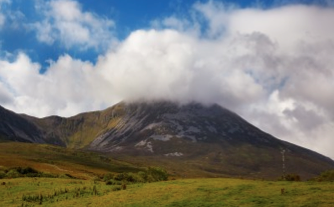On the last Sunday in July each year, some 25,000 to 40,000 people climb Croagh Patrick, or Reek Mountain. Recognized as St. Patrick’s sacred mountain, Croagh Patrick overlooks Clew Bay about five miles from the town of Westport. Long before the saint appeared in Ireland, Croagh Patrick was known as Cruach Aigli, a Gaelic phrase that translates to “stack of the eagle” and is sometimes interpreted as “Eagle’s Peak.”
While you’re enjoying your time of Travel Republic Ireland try staying at one of the Westport hotels, climb up Croagh Patrick during one of your stops in County Mayo. Even if you don’t come during the Reek Sunday pilgrimage, you will still see magnificent views of the Atlantic Ocean and a stunning perspective of the many islands of Clew Bay.
Pagan Beginnings
Some historians suggest that, to the pagans, Croagh Patrick was what Mount Olympus was to the Greeks. Others compare it to Egypt’s Mount Sinai and have nicknamed it “The Holy Hill of Ireland.” Archaeologists have discovered a large asymmetrical enclosure at the top of the mountain that predates Christianity. They’ve also found amber, blue and black glass bells that date from the 3rd century B.C. They estimate pagan worshippers climbed Croagh Patrick as early as 5000 B.C.
Long before the venerable St. Patrick arrived at the pinnacle of the holy hill, Irish gathered at the summit to celebrate the harvest and to appease the god Lugh. Storms in the sky were often believed to be battles between Lugh and his nemesis, Balor. Some scholars say that Lugh was a god of war, while others say he was considered a sun god. His closest parallel is the Roman god Mercury who, like Lugh, was the inventor and master of multiple arts.
St. Patrick and the Serpents
Today, Croagh Patrick serves as a touchstone of worship for many Catholics. According to legend, St. Patrick made a covenant with God that would allow him to judge the Irish people during the Last Judgment. St. Patrick ascended Croagh Patrick in 441 A.D., where he fasted for 40 days as part of his covenant with God.
While he was on the mountain, a flock of demons disguised as birds tried to disturb him during his solitude. St. Patrick rang his legendary Finn-Foya bell and banished the spirits to the Log na Deamhan, or the Lake of Demons. The bell was originally made from white metal, but it turned black because of Patrick’s constant clanging.
Because she was angry with St. Patrick for banishing the demons, the pagan goddess Corra supposedly took the form of a serpent and laid waiting in the waters of Lough Derg, or The Red Lake. St. Patrick descended the mountain and was swallowed by Corra. He stayed in her belly for two days and two nights before he cut himself free. Her blood turned the water red, and her body turned to stone to form the lake’s many islands. After St. Patrick killed Corra, all of the serpents supposedly left Ireland.
Reek Sunday
The Reek Sunday pilgrimage begins in the village of Murrisk at the base of the mountain. Some say St. Patrick climbed Croagh Patrick barefoot, and some of the tens of thousands of Reek Sunday pilgrims do the same. A statue of St. Patrick, erected by Reverend Father Patterson in 1928, serves as the first pilgrim station on the climb. The Boheh Stone, or the Chair of St. Patrick, is another site along the route. It’s a large rock on the eastern side of the mountain that is covered in Neolithic carvings. At the top of the mountain, Catholics celebrate mass and give confessions in a modern chapel.
In the centre of the town of Westport, an octagon with a pillar provides eight scenes from the life of St. Patrick. One of the panels reads, “The voice of the Irish, we ask you boy, come and walk once more among us.” Try to visit Croagh Patrick at least once, the haven of saints, gods and demons of old. You don’t have to embrace any particular creed or nationality, but you may find surprising spiritual sustenance along the way.
About the Author: George O’Connell is an amateur historian and a local expert on the history of Croagh Patrick. He takes the Reek pilgrimage each year.
